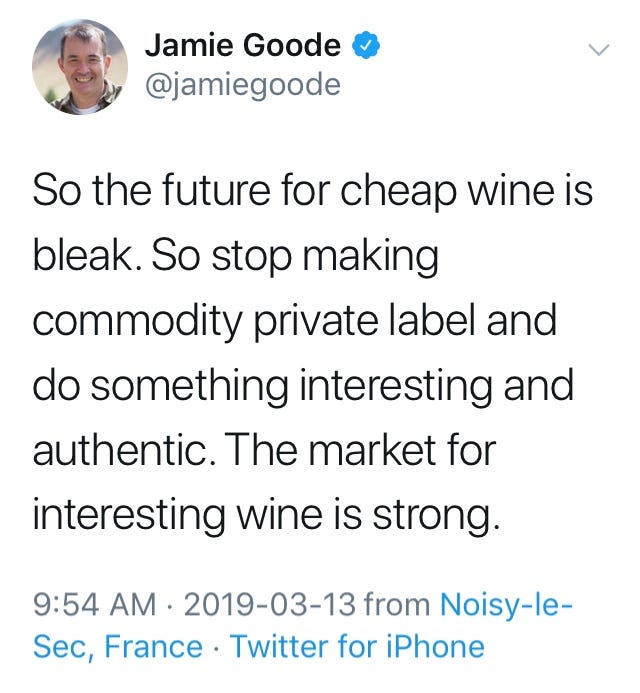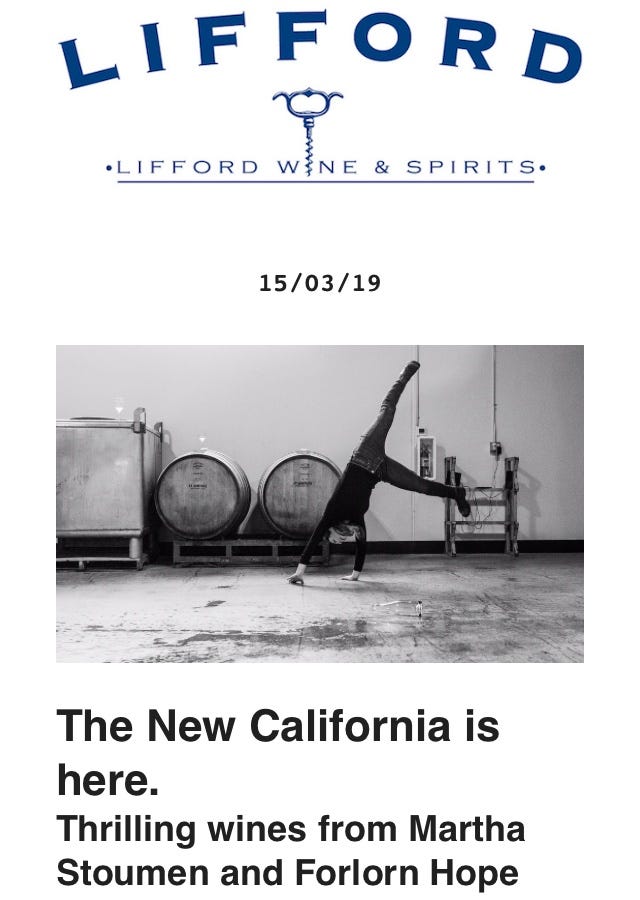What Makes A Wine Interesting?
The Market for Interesting Wine is Strong, according to wine journalist Jamie Goode. But what makes a wine interesting? For me, it’s the approach of the winemaker, their story, and the decisions they make. True natural winemakers are like artists, they didn't get into this to make a fast buck, they got into it to pursue a vision of making something authentic. Sure you can speed up the process with machines and additives and bada-bing-bada-boom you've got wine. But consumers - and even the Pope - have a thirst for authenticity and the purest expression of the vineyard. It’s what we don’t see that makes a wine interesting: the people behind it.

Stoked About These Rad New California Wines. Move over buttery Chardonnays and XL fruit bomb Cabs, there’s a new style of wine making in California by producers like Martha Stoumen and Forlorn Hope, whose wines are now being offered by Lifford. Stoumen apprenticed at vineyards all over the world, including Sicilian natural wine faves COS and Occhipinti (which may explain how she became a master of Nero d’Avola), and at Broc Cellars - another Cali winemaker making natural wine waves - before she founded her own winery because she wanted to recapture a culture that has all but faded away: a winemaking culture of patience. And Matthew Rorick’s Forlorn Hope strives for minimal intervention so that the character and uniqueness of each vineyard takes center stage. I copped a bottle of his 2012 Nacré, an organic Sémillon, from King & Spadina after this GW PSA, and I can’t wait to try the wine of one of the current pioneers of California's wine renaissance.

Gamay All Day. Sometimes called the poor man’s Pinot Noir, but officially known as Gamay Noir à Jus Blanc, the grape has become a symbol of both irreverence and authenticity in winemaking. Gamay is most often associated with the Beaujolais region of France and can be made using carbonic maceration (fermenting whole bunches of uncrushed grapes) resulting in a fresher, fruitier, poppier wine with low tannins, particularly chuggable when slightly chilled. Or it can be made like a more traditional red Burgundy, aging longer to create a deeper coloured, more tannic wine. There are ten Beaujolais crus (vineyards of recognized quality) where a Gamay from Fleurie may be lighter, and one from Morgon may be more full-bodied. Archive will be pouring 2016 Morgon “Côte de Py” Magnums from Jean Foillard at their Une Soirée Gamay on Monday, March 25. Jean was part of the Gang of Four who is said to have helped launch the natural wine movement in the 1970s. I’ve never had his wines but as winemaking runs in his family, I had the Cote de Brouilly from his son Alex Foillard, a Gamay with no additives or filtration, and I wish I had more of it.

There’s An App For That. While I prefer technological and mass-production methods to stay out of my wine, there is a role for technology in wine education. Delectable allows users to upload a photo of a wine label to see community-based reviews and tasting notes. And Raisin can help you find restaurants, bars and shops that specialize in organic, biodynamic, and low-sulfite wines, all around the world. I still mostly rely on Google and creeping on the Instagrams of wine importers and sommeliers, but a technological advancement I’d like to see would be Amazon-style personalized recommendations on the LCBO’s e-commerce platform, based on purchase and search history. Something like: Dear Rachel, since you ordered the Renner Waiting for Tom 2017 Zweigelt may we suggest the Pittnauer Pittnauski Burgenland 2015 Red Blend or the Clos Lentiscus Pet Nat Xarel-lo 2014 xoxo LCBO.



